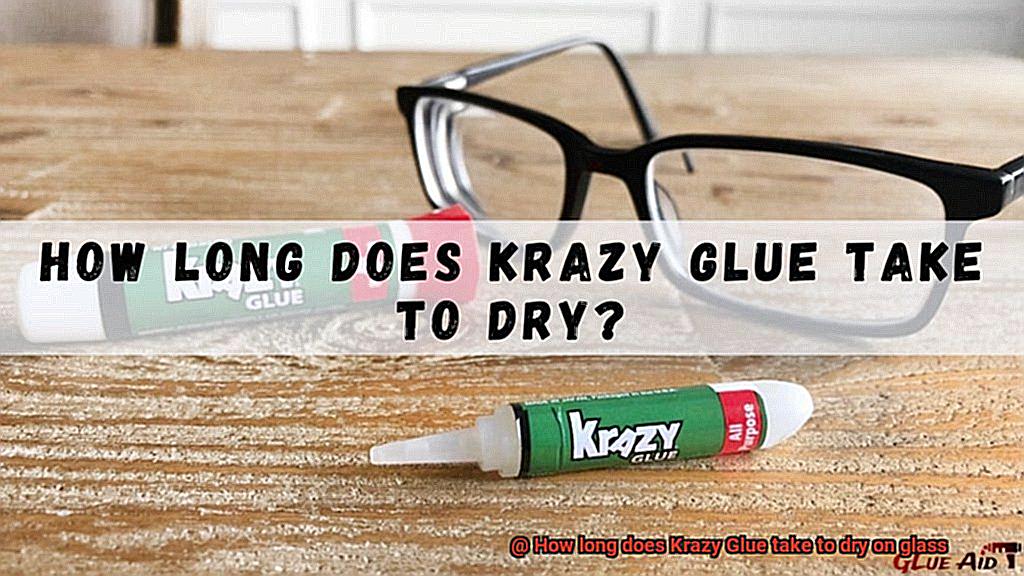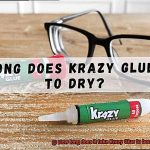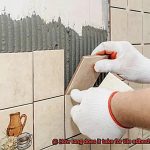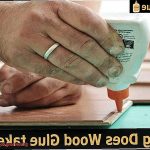Title: The Magic of Krazy Glue: How Long Does It Take to Dry on Glass?
Introduction:
Contents
- 1 Average Drying Time for Krazy Glue on Glass
- 2 Factors Affecting Drying Time of Krazy Glue on Glass
- 3 Tips for Speeding Up the Drying Process
- 4 How to Remove or Reposition Bonded Glass Objects Before They Have Fully Dried
- 5 Curing Period and Recommended Conditions
- 6 Techniques to Accelerate the Drying Process
- 7 Benefits of Using Krazy Glue on Glass Surfaces
- 8 Precautions When Handling Krazy Glue
- 9 Conclusion
Are you a DIY enthusiast or a crafty pro? Then you know the struggle of finding the perfect adhesive that can save your project from falling apart. Enter Krazy Glue, the legendary hero of the adhesive world. With its unmatched bonding strength and versatility, it’s become an essential tool in every toolbox.
But here’s the burning question: how long does Krazy Glue take to dry on glass? Glass surfaces are everywhere, from delicate ornaments to stunning stained glass creations. Knowing this crucial drying time can be the difference between success and a sticky disaster.
So get ready for a journey into the world of Krazy Glue as we uncover the secrets of its drying process on glass. It’s a fascinating blend of science, patience, and witnessing this liquid miracle transform into an unbreakable bond. Let’s dive in.
Average Drying Time for Krazy Glue on Glass
Krazy Glue is a renowned adhesive cherished for its formidable bond and rapid drying capabilities. When it comes to gluing glass, understanding the average drying time becomes crucial in ensuring successful and durable connections. In this insightful blog post, we will explore the various factors that affect drying time, provide tips for faster drying, and offer best practices for achieving optimal results.
Factors Affecting Drying Time:
The drying time of Krazy Glue on glass can be influenced by several factors, including temperature, humidity, and the amount of glue applied. Higher temperatures and lower humidity levels work as catalysts, accelerating the drying process, while lower temperatures and higher humidity levels slow it down. Applying a thin layer of glue facilitates faster drying.
Average Drying Time:
On average, Krazy Glue on glass can dry within an impressive range of 30 seconds to 2 minutes. However, it’s important to note that while the glue may be dry to the touch within this timeframe, complete curing can take several hours. To achieve maximum strength and durability, it is recommended to leave the glued objects undisturbed for at least 24 hours.
Tips for Faster Drying:
To expedite the drying process of Krazy Glue on glass, consider the following tips:
- Apply a thin layer of glue: Excess glue prolongs drying time.
- Roughen the glass surface: Enhancing adhesion shortens drying duration.
- Utilize a hairdryer on low heat: This method accelerates drying but demands caution to prevent glass damage or overheating.
Best Practices:
To attain optimal results when using Krazy Glue on glass, adhere to these best practices:
- Read and meticulously follow the manufacturer’s instructions.
- Allow sufficient curing time: Wait at least 24 hours before subjecting the bonded objects to stress or pressure.
- Maintain moderate temperature and humidity levels during the curing period.
- Handle Krazy Glue with care and follow safety precautions to ensure a successful and hazard-free application.
Factors Affecting Drying Time of Krazy Glue on Glass
Prepare to embark on a journey into the captivating realm of gluing techniques. Today, we unravel the enigmatic factors that influence the drying time of Krazy Glue on glass. From temperature’s dance with the glue’s molecules to the impact of surface preparation, these elements hold the key to successful bonding. So, let’s dive in and uncover the secrets.
Temperature: The Heat is On.
The temperature of your environment exerts a powerful influence over the drying time of Krazy Glue on glass. As temperatures rise, so does the glue’s speed of drying. In this heated atmosphere, the glue molecules awaken, eagerly bonding and solidifying at an accelerated pace.
Conversely, colder temperatures hinder molecular movement, extending drying time. So, if time is of the essence, bask in warmer surroundings.
Humidity: Friends or Foes?
Humidity levels in the air can be either allies or adversaries when it comes to gluing glass with Krazy Glue. High humidity saturates the atmosphere, impeding solvent evaporation and drawing out drying time.
On the other hand, low humidity promotes swift solvent evaporation, resulting in quicker bonding. Before embarking on your adhesive adventure, consult your local humidity levels to navigate this delicate balance.
Thickness of Glue Layer: Thin is In.
The thickness of the layer of Krazy Glue applied to glass directly affects drying time. Thicker layers require more solvent evaporation and additional bonding time, prolonging drying time. To expedite this process, opt for thin layers that facilitate quick solvent evaporation and forge stronger bonds.
Surface Preparation: The Key to Success.
Before embracing Krazy Glue’s bonding prowess, meticulously prepare your glass surface. Banish dust, dirt, and grease to ensure seamless adhesion and expedited drying time. A pristine, velvety canvas provides the ideal foundation for the glue to bond effectively and dry with lightning speed.
Type and Quality of Krazy Glue: Choose Wisely.
Not all Krazy Glue creations are equal in terms of drying time. Some variations prioritize rapid bonding and swift drying, while others focus on forging unyielding bonds that necessitate slightly longer drying times. Selecting high-quality Krazy Glue ensures optimal performance and predictable drying times, empowering you to navigate your adhesive journey with confidence.
Ventilation: Let the Air Flow.
Proper ventilation stands as a secret weapon for expediting drying time. A breath of fresh air removes fumes and dispels trapped moisture, hastening the drying process. Adequate ventilation prevents solvent accumulation, which can impede drying time and compromise bond quality. So, crack open a window or let a fan paint the air with a gentle breeze.
Pressure and Contact Time: The Extra Push.
To accelerate drying time, apply gentle pressure and maintain contact between the glued surfaces. This technique ensures even distribution of the glue, maximizing contact area and expediting bonding. Bear in mind not to exert excessive pressure that could shatter glass or disrupt alignment.
Tips for Speeding Up the Drying Process
Krazy Glue is a versatile adhesive that can bond various materials, including glass. While it is known for its quick-drying capabilities, there are times when you may need to speed up the drying process. In this blog post, we will share some handy tips to help you achieve faster drying times when working with Krazy Glue on glass surfaces.
Clean and Prep the Glass Surface:
Before applying Krazy Glue, it’s crucial to start with a clean canvas. Dirt, dust, or oils on the glass surface can interfere with the adhesive’s ability to bond properly and may result in longer drying times. To ensure a strong and quick bond, use a mild detergent or glass cleaner to wipe the surface clean. Afterward, dry it thoroughly with a lint-free cloth. This step not only improves adhesion but also promotes faster drying.
Apply a Thin and Even Layer:
When it comes to applying Krazy Glue on glass, less is more. To speed up the drying process, apply the adhesive in a thin and even layer. Excessive glue takes longer to dry and can create a messy appearance. By using just the right amount of glue, you facilitate better contact between the adhesive and the glass surface, leading to faster drying times. Remember, a little goes a long way.
Utilize Gentle Heat:
If time is of the essence and you need your Krazy Glue to dry quickly on glass, consider using gentle heat. You can employ a hairdryer set on low heat or place the glued glass object near a warm source like sunlight or a radiator. The gentle warmth helps evaporate solvents in the glue, reducing drying time significantly. Just be cautious not to overheat the glass or subject it to direct flames, as this may cause damage.
Consider an Accelerator:
For those situations where you’re in a rush and need the glue to dry even faster, consider using an accelerator or activator specifically designed for cyanoacrylate adhesives like Krazy Glue. These products work by speeding up the chemical reaction and promoting faster curing. However, it’s essential to follow the manufacturer’s instructions carefully to ensure optimal results. Accelerators can be a great option when time is of the essence, but remember to exercise caution and test on a small area first before applying them to larger or more important projects.
Exercise Patience:
While it’s tempting to rush the drying process, it’s crucial to exercise patience and allow sufficient time for Krazy Glue to fully cure. While the glue may appear dry on the surface, it’s essential to remember that curing takes time. Generally, it takes around 24 hours for Krazy Glue to fully cure on glass, but this timeframe may vary depending on environmental factors such as temperature and humidity. Rushing the process may compromise the bond’s strength and durability, so it’s best to err on the side of caution and give it ample time to dry naturally.
How to Remove or Reposition Bonded Glass Objects Before They Have Fully Dried
Working with bonded glass objects can be a delicate task, especially when you need to remove or reposition them before the adhesive has fully dried. In this blog post, we will explore the best practices and techniques to safely separate bonded glass objects without causing any damage. Whether you’re a DIY enthusiast or a professional, these tips will help you navigate the process smoothly.

Assessing the Bond:
Before attempting to remove or reposition bonded glass objects, it is crucial to assess the strength of the bond. If the bond is weak or not fully cured, it will be easier to separate the objects without causing any damage. Gently try to apply pressure or leverage to the bonded area using tools like a putty knife, a plastic scraper, or even your fingers (if safe to do so). By assessing the bond’s strength, you can determine whether it is possible to proceed with removal or repositioning.
Applying Solvent:
Using a solvent compatible with the adhesive used can help loosen the bond. Acetone or nail polish remover are effective options. Apply a small amount of solvent to a clean cloth and gently rub it onto the bonded area. Avoid applying excessive pressure, as it may crack or scratch the glass. The solvent will work by breaking down the glue and weakening its hold on the glass surfaces.
Applying Heat:
Heat application can also help loosen the bond between bonded glass objects. Use a hairdryer or heat gun on a low setting, directing the heat towards the bonded area for a few minutes. Be cautious not to apply excessive heat that may cause thermal stress on the glass, leading to breakage. The heat will soften the glue, making it easier to separate the objects.
Cutting through the Adhesive:
If solvents or heat methods are not effective in loosening the bond, cutting through the adhesive may be necessary. Use a sharp utility knife or razor blade to carefully cut along the edges of the bonded area. Apply controlled pressure in a slow and gentle manner to avoid injury or damage. Take your time and ensure that you are following a steady cutting path.
Cleaning up Residue:
After successfully removing or repositioning the bonded glass objects, there may be residual glue left on the surface. Use a cloth soaked in acetone or adhesive remover to gently wipe away any remaining residue. Follow the instructions on the adhesive remover product and handle chemicals with caution. Thoroughly clean the glass surface to restore its appearance and ensure there are no residues left behind that could affect future bonding attempts.
Curing Period and Recommended Conditions
In the world of adhesives, Krazy Glue is the ultimate hero when it comes to bonding glass objects. But before you embark on your gluing adventure, it’s vital to understand the curing period and recommended conditions for using Krazy Glue on glass. In this article, we’ll delve into why these factors are essential for achieving outstanding results.
Curing Period: The Waiting Game
When it comes to gluing glass with Krazy Glue, patience is your best friend. While this adhesive is renowned for its lightning-fast drying capabilities, reaching maximum strength requires a curing period of 24 hours. During this time, handle your glued glass object with tender care to safeguard the bond. Remember, greatness comes to those who wait.
Recommended Conditions: The Recipe for Success
To ensure a robust and enduring bond, follow these recommended conditions when working with Krazy Glue on glass:
Clean and Dry Surface:
Before applying Krazy Glue, make sure the glass surface is squeaky clean and free from dirt, dust, or oil. Employ a mild detergent or rubbing alcohol to wipe away any contaminants, then let the glass air dry completely. A pristine surface lays the groundwork for an impeccable bond.
Temperature and Humidity:
Just like Goldilocks’ quest for the perfect porridge, Krazy Glue thrives in moderate temperatures ranging from 50°F (10°C) to 85°F (29°C). Extreme temperatures can affect the glue’s performance, so stick within this recommended range. Additionally, maintaining moderate humidity levels (around 40-60%) creates an optimum curing environment.
Ventilation:
Working with Krazy Glue on glass releases fumes that may irritate the respiratory system. To avoid discomfort, ensure your workspace boasts excellent ventilation. Crack open those windows or employ a fan to keep the air flowing, allowing you to breathe easy as you glue.
Avoid Excessive Moisture:
While moderate humidity aids in curing, excessive moisture can weaken the bond. Keep your glued glass object away from water or excessive humidity until the adhesive has fully cured. This precaution guarantees the long-lasting durability of your bond.
Techniques to Accelerate the Drying Process
Look no further. In this article, we will explore some techniques that can help you speed up the drying process of Krazy Glue on glass. With these tips, you’ll be able to achieve a strong bond in no time.
Increase air circulation:
One simple yet effective way to accelerate the drying process is by increasing air circulation around the glued area. Use a fan or open windows to allow for better airflow. This helps evaporate the solvent in the glue faster, resulting in quicker drying and less waiting time for you.
Apply heat with caution:
Heat can be a powerful ally in speeding up the drying process. Use a hairdryer set on low heat and hold it a few inches away from the glued area. The gentle warmth aids in evaporating the solvent and reduces drying time. Remember to use caution with heat on glass to avoid damage.
Use a dehumidifier:
In high humidity environments, moisture in the air can hinder the drying process. Using a dehumidifier reduces the moisture content, allowing the glue to dry faster. Lower humidity means less moisture for the glue to contend with, resulting in quicker drying times.
Thin application is key:
When applying Krazy Glue on glass, remember that thin is in. Thicker layers take longer to dry as there is more solvent that needs to evaporate. Apply thin layers to decrease drying time and ensure a stronger bond. A little goes a long way.
Harness the power of accelerators:
Some super glue brands offer accelerators that can be applied before bonding. These speed up the curing time of the glue, allowing it to dry faster on glass. Follow manufacturer’s instructions when using these handy tools.
Opt for fast-drying variants:
Look for Krazy Glue variants specifically designed for fast drying on glass. These typically have shorter drying times than regular glues, saving you precious minutes and ensuring a reliable bond.
Clean and dry the surface:
Before applying Krazy Glue on glass, ensure the surface is clean and dry. Moisture or residue can hinder the drying process. Clean with a mild detergent or glass cleaner, and thoroughly dry before applying the glue for optimal results.
Benefits of Using Krazy Glue on Glass Surfaces
When it comes to repairing glass objects, there’s no better adhesive than Krazy Glue. This popular adhesive is known for its strong bonding capabilities on various surfaces, but it truly shines when used on glass. So what exactly are the benefits of using Krazy Glue on glass surfaces? Let’s dive in and find out.
First and foremost, one of the major advantages of using Krazy Glue on glass surfaces is its quick drying time. Unlike other adhesives that may take hours or even days to fully dry, Krazy Glue can dry within minutes. This means no more waiting around for your project to be complete. Whether you’re repairing a broken glass item or creating intricate glass crafts, the fast drying time of Krazy Glue eliminates the need for clamps or supports to hold the pieces together while the adhesive sets.
But it’s not just about speed – Krazy Glue offers a strong bond that can withstand heavy loads and general wear and tear. Once dried, this adhesive forms a powerful bond that ensures your repaired glass items stay intact for the long haul. Say goodbye to constantly fixing your favorite picture frame or worrying about your eyeglasses falling apart.
Speaking of durability, Krazy Glue is also resistant to water and heat. This means that your bond won’t weaken or deteriorate when exposed to moisture or high temperatures. So whether you’re using it in the bathroom or near hot appliances, you can trust that your repaired glass items will hold up under any conditions.
Now let’s talk aesthetics. When using Krazy Glue on glass surfaces, you don’t have to worry about any unsightly residue ruining the appearance of your project. This adhesive dries clear and remains virtually invisible on transparent materials like glass. The repaired or bonded area will maintain its original appearance, so you can proudly display your restored glass items without any visible signs of adhesive.
But that’s not all – Krazy Glue is also incredibly easy to use. It comes in small, convenient tubes with precision applicators, allowing for precise application without any mess. Whether you’re a professional or a DIY enthusiast, you’ll find Krazy Glue accessible and user-friendly.
And let’s not forget about its long shelf life. You can store Krazy Glue for extended periods without worrying about it losing its effectiveness. This makes it a reliable adhesive to have on hand for any future glass repair or bonding needs.
Precautions When Handling Krazy Glue
When it comes to handling Krazy Glue, there are several precautions you should keep in mind to ensure your safety and the success of your projects.
Firstly, it’s important to protect your hands from accidental bonding. Krazy Glue is just as effective on skin as it is on glass, so wearing gloves or applying a barrier cream before using the glue is a must.
In addition, the fumes from Krazy Glue can be strong and irritating. To keep the air clear and fresh, make sure to work in a well-ventilated area, open windows, or use a fan.
If you have children or pets around, be sure to store Krazy Glue securely out of their reach. It’s not meant for ingestion and can cause serious health issues if swallowed.
When working with glass surfaces, cleanliness is key. Thoroughly clean the area before applying Krazy Glue to ensure a strong bond. Use a mild glass cleaner or rubbing alcohol to remove any dirt, dust, or oils that could interfere with adhesion.
Remember, less is more when it comes to using Krazy Glue on glass. A small amount goes a long way, and applying too much can result in excess seeping out from the bond line, which can be difficult to remove and unsightly.
Accidents happen, but knowing how to handle them is crucial. If you experience spills or skin contact with Krazy Glue, don’t panic. For skin contact, soak the affected area in warm soapy water or acetone to dissolve the adhesive. If glue gets in your eyes, rinse them thoroughly with water and seek medical attention immediately.
Lastly, proper storage is essential to maintain the quality of your Krazy Glue. Keep the cap tightly sealed after each use to prevent drying out. Store it in a cool, dry place away from direct sunlight.
QthlA8A8G3s” >
Also Read: Krazy Glue – Glue Things
Conclusion
Krazy Glue on glass is a sticky situation. You’re probably wondering, how long does it take for this super adhesive to dry? Well, let me tell you, patience is key. When you apply Krazy Glue to glass, it starts to bond almost instantly. Within seconds, you’ll feel the glue gripping onto the surface with its mighty strength.
But don’t be fooled by its initial stickiness. While it may seem like the glue has dried completely, it’s important to give it some time to fully cure. The process of drying and curing are not one and the same. Drying refers to the evaporation of solvents in the glue, while curing involves chemical reactions that create a strong bond.
On average, Krazy Glue takes about 24 hours to fully cure on glass. Yes, I know that sounds like a long time, but trust me, it’s worth the wait. This extra time allows the glue to reach its maximum strength and durability.
So what should you do while waiting for your Krazy Glue masterpiece to dry? Well, why not take this opportunity to explore your creative side? Plan your next DIY project or brainstorm ideas for how you’ll showcase your newly repaired glass item.
Remember, when working with Krazy Glue on glass, precision is key. Apply just enough glue to create a thin layer and ensure proper bonding. And if any excess glue spills over onto surrounding areas, don’t panic. Simply wipe it away with acetone or nail polish remover before it dries.
In conclusion, when using Krazy Glue on glass, be prepared for instant grip but allow 24 hours for full curing. Embrace this waiting period as an opportunity for creativity and planning your next project.






